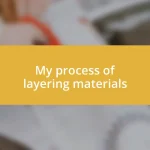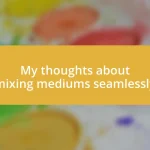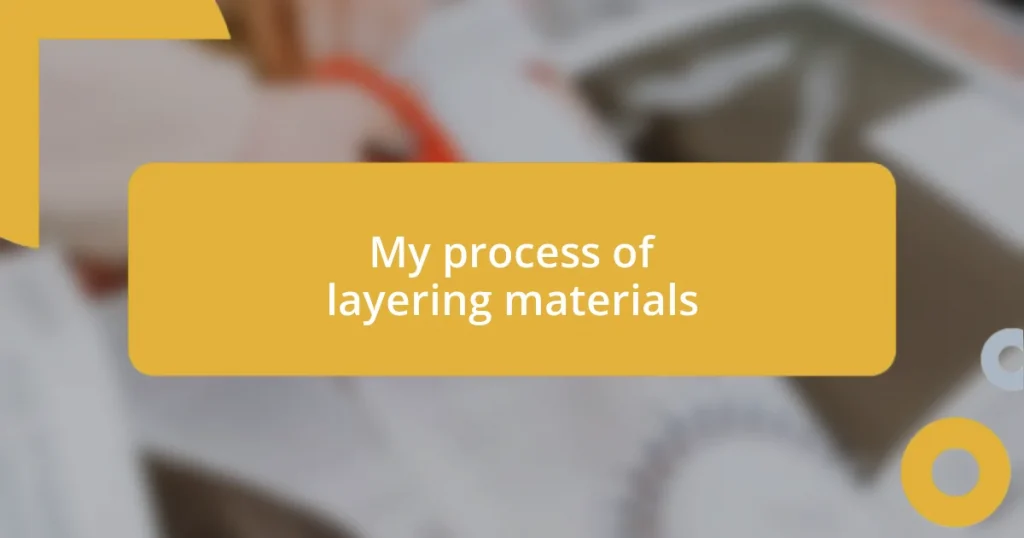Key takeaways:
- Textures in narratives enhance emotional connections, allowing readers to feel and experience alongside characters through sensory details and environmental elements.
- Creating balance in textures ensures a seamless narrative flow, using contrasting and layered sensory elements to evoke complex emotions and enhance reader engagement.
- Incorporating sensory immersion and emotional layering enriches storytelling, making narratives more immersive and resonant, prompting readers to reflect on their own experiences.

Understanding narratives with textures
When I think about narratives with textures, I recall a project where I layered different narrative threads like threads in a tapestry. Each character’s journey was depicted not just through their actions, but by the subtle textures of their surroundings, enhancing the emotional weight of their stories. Have you ever considered how a simple change in setting can deepen the reader’s connection to characters?
There’s something profoundly enriching about describing a character’s environment in ways that evoke sensations, tastes, and sounds. I remember writing a scene where a character walked through a bustling market; the vibrant colors and lively chatter added a palpable energy that resonated with the protagonist’s own turmoil. This technique transforms a narrative from mere storytelling into a vivid tapestry that invites readers to not just witness, but to feel and experience alongside the characters.
Textures in narratives don’t have to be physical; they can also manifest in emotional layers. For instance, when crafting a story about loss, I used the thin, fragile quality of an autumn breeze to mirror the character’s grief. This emotional texture creates a resonance that can linger with the reader long after they’ve closed the book. Don’t you find that these nuanced details contribute to a more immersive experience?

Identifying textures in storytelling
Identifying textures in storytelling requires a keen eye for detail and an understanding of how different elements interact within a narrative. I often find myself examining not just what my characters are seeing or doing but how their environments impact their emotional states. For example, during a recent story, I chose to set a pivotal scene in a dimly lit room filled with old photographs and dusty furniture. This space, laden with memories, inherently added a layer of nostalgia and estrangement, reflecting the character’s inner conflict.
To pinpoint textures in storytelling, consider these aspects:
– Setting: How does the environment influence the mood?
– Sensory Details: What sounds, smells, and sights surround the characters?
– Emotion: In what ways can physical textures mirror emotional states?
– Character Interaction: How do characters engage with their surroundings?
– Symbolism: Are there objects that carry deeper meanings within the narrative?
By examining these components, you can enrich your narrative tapestry, allowing readers to fully engage and connect with the story on a multi-sensory level.

Techniques for layering textures
When it comes to layering textures, my approach has always involved combining various sensory details to create depth. I remember a time when I wrote about a character navigating a rain-soaked street. The textures of the slick pavement, the smell of wet earth, and the distant rumble of thunder all worked together to evoke a sense of foreboding. Wouldn’t you agree that these layered elements invite readers to step into the scene?
One technique I love is using contrasting textures to illustrate conflict. In one story, I juxtaposed the stark, sterile environment of a hospital with the warmth of a caregiver’s comforting touch. This contrast not only highlighted the character’s vulnerability but also emphasized their longing for connection in a cold, clinical space. It’s fascinating how different textures can evoke complex emotions, don’t you think?
An effective technique I often utilize is focusing on the movement within textures. For instance, in a narrative about the ocean, I described the soft shifting of sand beneath bare feet, contrasted with the sharp sting of seawater during high tide. This layering of physical sensations adds richness and allows the reader to feel the ebb and flow of the character’s experience. Have you tried capturing movement in your narratives?
| Technique | Description |
|---|---|
| Sensory Combination | Incorporating various sensory elements to create depth and immersion. |
| Contrasting Textures | Using opposing textures to highlight emotional conflict and connection. |
| Movement Within Textures | Focusing on how textures change and evoke emotions through the character’s experiences. |

Creating emotional connections through textures
When I think about creating emotional connections through textures, I often reflect on my experience crafting scenes that feel palpable. In one story, I described a character running their fingers along the threads of a well-worn blanket. That simple action ignited a flood of memories for them, intertwining comfort and loss. Isn’t it remarkable how a single texture can transport us back to a moment filled with warmth or sadness?
Additionally, textures play a significant role in how I evoke empathy for my characters. I vividly recall writing about a protagonist standing in a frigid windswept field, their skin prickling with cold. Through contrasting that with the inviting warmth of the sun on their face moments later, I aimed to mirror their internal struggle between hope and despair. Have you ever considered how such palpable sensations shape our connection to a character’s emotional journey?
I also find that textures can elevate suspense in storytelling. For example, in a recent narrative, I detailed the gritty feel of an old, cracked leather-bound journal the character clutched tightly. The ruggedness of the journal contrasted sharply with their fragile emotional state, building tension as they prepared to unearth memories they had long buried. By weaving these textures into the narrative, I not only heightened the intensity but crafted an emotional bridge between the character and the reader. How do you perceive the impact of texture in your own storytelling?

Balancing textures for narrative flow
Balancing textures is essential for creating a seamless narrative flow. I’ve realized that if the textures clash too harshly, readers might feel jarred from one moment to the next. For instance, while working on a piece set in a bustling marketplace, I blended the vibrant sounds of laughter with the muted smell of spices. This combination struck just the right balance, allowing readers to experience the chaos without losing their footing in the story. Have you found that harmony in your narratives?
Sometimes, I lean into subtle shifts in texture to guide the reader’s emotions. I remember crafting a scene where a character transitioned from the cool shade of an ancient tree to the warm glow of a sunset. This gradual change in texture, both visual and temperature-related, not only illustrated the character’s journey but also mirrored their shifting mindset. It’s curious how these fluctuations can lead to a deeper emotional resonance, don’t you think?
In another story, I played with the notion of layering textures to establish a rhythm. By alternating between sharp, vivid imagery and softer, more introspective moments, I kept the momentum flowing. When a character stumbled upon a childhood toy amidst the harsh backdrop of a crumbling building, it created a poignant pause in the narrative. I find that such contrasts invite readers to reflect on their own experiences, adding depth to the overall emotional landscape. How do you incorporate rhythm through texture in your own writing?

Examples of textured narratives
Reflecting on textured narratives, I recall writing about a character standing on the precipice of a cliff, the jagged rocks beneath their feet feeling both dangerous and grounding. The sharpness of the stones served as a metaphor for their precarious mental state, creating a tangible sense of tension. This interplay of texture and emotion invites the reader to contemplate the risks of vulnerability—what do we cling to in our moments of uncertainty?
One of my favorite examples is when I depicted a scene in a cozy bookstore during a rainy afternoon. The familiar scent of coffee mixed with the musty smell of old books enveloped the protagonist like a warm hug. This blend of textures wasn’t just about setting; it was about conjuring a safe space for reflection amidst the chaos of life. Can you think of a time when a particular environment resonated with your emotions, shaping your experience?
There’s also the raw intensity of textures that can evoke strong reactions. In another narrative, I described a character’s hands, which were marred by calluses, as they worked on a delicate piece of art. The contrast between their rugged hands and the fragile materials underscored the struggle of creativity and self-expression. It made me realize how deeply intertwined our physical experiences are with our emotional journeys—how often do we overlook the stories our bodies tell?

Tips for enhancing narrative textures
One of my favorite approaches to enhancing narrative textures is through sensory immersion. For instance, while writing a scene set in a bustling café, I made sure to include the sizzling sound of espresso machines alongside the rich aroma of freshly brewed coffee. This multisensory detail not only brought the setting to life but also evoked a warm, inviting atmosphere that made readers feel like they were sitting right there, sipping a cup themselves. Have you ever considered how sensory details can pull your readers into a scene?
Additionally, I’ve found that juxtaposing contrasting textures can create a compelling tension that captures attention. I vividly remember a moment in my writing where I described a loud, chaotic city street suddenly giving way to the serene stillness of a nearby park. The shock of this shift created a palpable sense of relief for the reader, mirroring the character’s need to escape. It’s intriguing how these contrasts can emphasize emotional shifts, isn’t it?
Moreover, layering emotional textures is crucial for adding depth to a narrative. When I crafted a scene where a character revisited their childhood home, I made sure to weave in tactile memories—like the coolness of the hardwood floor and the scratchy feel of old wallpaper. Each texture evoked nostalgia, enhancing the emotional weight of their journey. I’ve realized that when I layer these textures thoughtfully, they resonate powerfully with readers, making them reflect on their own memories. What textures do you think evoke strong emotions for your readers?















